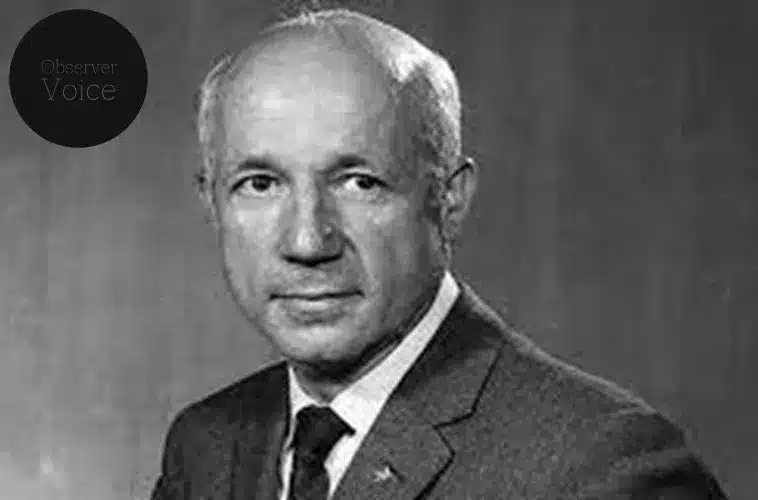Melvin Calvin (8 April 1912 – 8 January 1997) was an American biochemist who won the 1961 Nobel Prize in chemistry for discovering the Calvin cycle along with Andrew Benson and James Bassham.
Life and Career
He was born on 8 April 1912, in Minnesota, U.S. In 1928, he graduated from Central High School. Following that, he studied at the Michigan College of Mining and Technology and got a Bachelor of Science in Chemistry, in 1931. He earned a Ph.D. in 1935 at the University of Minnesota. During his time under George Glocker’s mentorship, he wrote his thesis about electron affinity for halogens.
He then got a Rockefeller Foundation grant and went to the University of Manchester to do his postdoctoral work. While there, he studied metalloporphyrins, activation of molecular hydrogen, and coordination catalysis under Professor Michael Polanyi. At Manchester University, he joined Michael Polanyi’s lab as a post-Doctoral student. He spent two years studying organic molecules in the lab.
His parents ran a grocery store in Detroit when he was a kid, so Melvin Calvin grew up there. Melvin Calvin was often found exploring his curiosity by looking through all the products that made up their shelves. Something he quickly recognized was the importance of chemistry to everyday products and our daily lives.
He was inducted into the University of California at Berkeley, in 1937. He rose through the ranks slowly, becoming a Full Professor in 1947 and then a Professor of Molecular Biology in 1963, a post he held until he retired in 1980. Following his work on molecular hydrogen activation at Manchester, he studied the color of organic compounds, which led him to investigate organic molecule electronic structures at Berkeley.
During the 1940s, he investigated molecular genetics and suggested hydrogen bonds may play a role in piling up nucleic acid bases in the thread-like structures called chromosomes. Calvin worked for the ‘National Defense Research Council’ when the United States entered the Second World War. He worked on cobalt complexes that reverse-bonded with oxygen to generate oxygen for destroyers or submarines. As a result of his development, patients suffering from breathing problems can get oxygen from the atmosphere.
Among his contributions to the Manhattan Project, a wartime research and development project to develop atomic bombs was working on separating plutonium from uranium’s other irradiated nuclear fission products using solvent extraction. In 1946, he was the founder-director of Lawrence Radiation Laboratory, an interdisciplinary bio-organic chemistry group. He was also the Associate Director of the Lawrence Radiation Laboratory until 1980, where he did a lot of his research work.
He won the Nobel Prize for developing an understanding of how plants convert water and carbon dioxide into carbohydrates using sunlight and chlorophyll. In collaboration with James Bassham and Andrew Benson, Calvin traced the path carbon traveled through a plant during photosynthesis using the radioactive isotope carbon-14. They explained the tracer technique in ‘Isotopic Carbon’ (1949).
They showed that sunlight triggers organic compounds by acting on chlorophyll in plants, not carbon dioxide. During his investigation, he suspended green algae, chlorella, in water, then exposed it to light and added carbon dioxide containing carbon-14. While algae produced carbohydrates from water, carbon dioxide, and minerals, a newly developed research device, paper chromatography, was used to identify carbon-14.
By measuring radioactive carbon at different stages of photosynthesis, it became possible to identify compounds. These findings were detailed in ‘The Path of Carbon in Photosynthesis’ (1957) and ‘The Photosynthesis of Carbon Compounds’ (1962). He was the president of the ‘American Society of Plant Physiologists from 1963 to 1964.
He was made a member of Dow Chemical Company’s board of directors in 1964. A member of many scientific boards of the US government, he served twice on the ‘Science Advisory Committee’ of Presidents Kennedy and Johnson. He became president of the American Chemical Society in 1971. He was a member of the ‘Royal Society of London and the ‘National Academy of Sciences’.
He died on 8 January 1997, in Berkeley, California, U.S.
Notable Works
Melvin Calvin was an American biochemist who made significant contributions to the field of chemistry and biology. Here are some of his notable works:
- Calvin Cycle: Calvin is best known for discovering the Calvin cycle, also known as the Calvin-Benson-Bassham Cycle. This is a series of biochemical reactions that take place in the chloroplasts of green plants during photosynthesis.
- Hydrogen Activation: Calvin conducted investigations on hydrogen activation.
- Radiation Chemistry: He made significant contributions to the field of radiation chemistry.
- Electronic Structure of Organic Molecules: Calvin studied the electronic structure of organic molecules.
- Artificial Photosynthesis: He worked on artificial photosynthesis.
- Photoelectronic, Electronic and Photochemical Behaviour of Porphyrins: Calvin studied the photoelectronic, electronic and photochemical behaviour of porphyrins.
- Chemical Evolution of Life: He also researched the chemical evolution of life.
In addition to these, Calvin wrote seven books and more than 600 scientific articles throughout his career. His autobiography, “Following the Trail of Light: A Scientific Odyssey”, was published in 1992. For his remarkable contributions, he was awarded the Nobel Prize in Chemistry in 1961.
Award and legacy
In 1961 he received the ‘Nobel Prize’ in Chemistry for discovering the Calvin cycle along with Andrew Benson and James Bassham.

